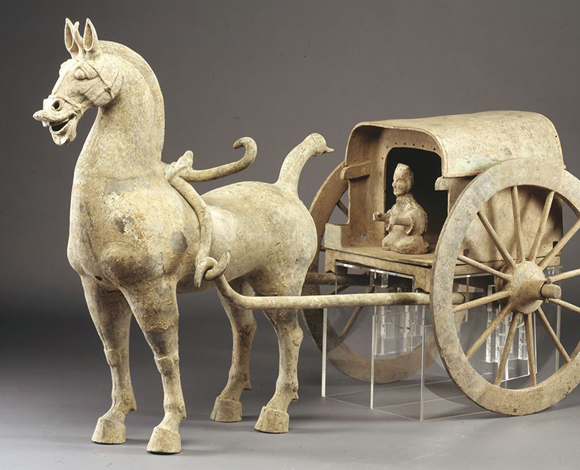中國古代戰車
Ancient Chinese Chariots
- 出題日期
- 2018/12/15、2016/4/16
- 命中課本
- 菁英雅思機經「人文與電腦科學」
- 延伸閱讀
- 劍雅 11-1-2 The Falkirk Wheel
- 中文說明
-
 秦兵馬俑是在
1974 年 3 月 29 日於陝西西安東部被人發現。當時發生大旱,在驪山秦始皇陵墓以 東約 1.6 公里處,一群當地的農民在挖井打水時意外發現兵馬俑碎片,該處充滿了地下水和水道。 專家計算全部共有 8,000 個士兵,有
130 輛戰車(每輛 130 公分長),530 匹馬和 150 匹騎兵 馬,它們是用來抵禦來世的危險。相較之下,圖坦卡門陵墓的戰車就不是以數量取勝,該處共出土了 6 輛戰車,它們以精湛的設計、極其複雜和令人吃驚的現代技術而著稱,它們可乘載雙人(每輛
90 公分長),並且可以穿過狹窄的走廊進入墳墓 ...
秦兵馬俑是在
1974 年 3 月 29 日於陝西西安東部被人發現。當時發生大旱,在驪山秦始皇陵墓以 東約 1.6 公里處,一群當地的農民在挖井打水時意外發現兵馬俑碎片,該處充滿了地下水和水道。 專家計算全部共有 8,000 個士兵,有
130 輛戰車(每輛 130 公分長),530 匹馬和 150 匹騎兵 馬,它們是用來抵禦來世的危險。相較之下,圖坦卡門陵墓的戰車就不是以數量取勝,該處共出土了 6 輛戰車,它們以精湛的設計、極其複雜和令人吃驚的現代技術而著稱,它們可乘載雙人(每輛
90 公分長),並且可以穿過狹窄的走廊進入墳墓 ...
- 高分單字
-
chariot n. (古代的)雙輪戰車(或比賽馬車)
A chariot is a two-wheeled vehicle drawn by horses, used in ancient racing and warfare.
dynasty n. 朝代
雙輪戰車是一種兩輪馬車,在古代用來從事競賽或戰爭。The Qing dynasty ruled over China for 268 years.
excavate v. 發掘(古物等)
清朝統治中國 268 年。The archaeologists excavated a buried palace.
ruins n. 遺址
考古學家發掘出一個埋在地下的皇宮。They visited a Roman ruin.
ritual adj. (宗教)儀式的,典禮的
他們遊覽了一處古羅馬遺址。On this festival, there are dances, and ritual sacrifices of animals.
sacrifice n. (供奉神的)牲禮,祭品;獻祭
在這個節日,會有舞蹈以及宗教儀式的牲祭。The people of the village offered an ox on the altar as a sacrifice for their sins.
archaeological adj. 考古學的
村民在祭壇上獻祭一頭公牛作爲贖罪的祭品。Why the change took place is still an archaeological mystery. 這個變化為什麼會發生,在考古學上還是一個謎。
artifact n. 工藝品;手工藝品He owns three artifacts stores in the city.
unearth v. 發掘,掘出,使出土
他在這個城市擁有三間工藝品店。After human remains were unearthed, building at the site was suspended.
terracotta n. 赤陶;赤土
在工地挖出人類遺骸之後,施工就停止了。Most of the terracotta warriors stand facing east.
兵馬俑大都是向東而立。 - 看出題原文
-
Ancient Chinese Chariots
The Shang Dynasty or Yin Dynasty, according to traditional historiography, ruled in the Yellow River valley in the second millennium BC. Archaeological work at the Ruins of Yin (near modern- day Anyang), which has been identified as the last Shang capital, uncovered eleven major Yin royal tombs and the foundations of palaces and ritual sites, containing weapons of war and remains from both animal and human sacrifices.
The Tomb of Fu Hao is an archaeological site at Yinxu, the ruins of the ancient Shang Dynasty's capital Yin, within the modern city of Anyang in Henan Province, China. Discovered in 1976, it was identified as the final resting place of the queen and military general Fu Hao. The artifacts unearthed within the grave included jade objects, bone objects, bronze objects etc. These grave goods are confirmed by the oracle texts, which constitute almost all of the first hand written record we possess of the Shang Dynasty. Below the corpse was a small pit holding the remains of six sacrificial dogs and along the edge lay the skeletons of human slaves, evidence of human sacrifice.
The Terracotta Army was discovered on 29 March 1974 to the east of Xi’an in Shaanxi. The terracotta soldiers were accidentally discovered when a group of local farmers was digging a well during a drought around 1.6 km (1 mile) east of the Qin Emperor's tomb around at Mount Li (Lishan), a region riddled with underground springs and watercourses. Experts currently place the entire number of soldiers at 8,000—with 130 chariots (130 cm long), 530 horses and 150 cavalry horses helping to ward off any dangers in the afterlife. In contrast, the burial of Tutankhamun yielded six complete but dismantled chariots of unparalleled richness and sophistication. Each was designed for two people (90 cm long) and had its axle sawn through to enable it to be brought along the narrow corridor into the tomb.
Excavation of ancient Chinese chariots has confirmed the descriptions of them in the earliest texts. Wheels were constructed from a variety of woods: elm provided the hub, rose-wood the spokes and oak the felloes. The hub was drilled through to form an empty space into which the tempered axle was fitted, the whole being covered with leather to retain lubricating oil. Though the number of spokes varied, a wheel by the fourth century BC usually had eighteen to thirty-two of them. Records show how elaborate was the testing of each completed wheel: flotation and weighing were regarded as the best measures of balance, but even the empty spaces in the assembly were checked with millet grains. One outstanding constructional asset of the ancient Chinese wheel was dishing. Dishing refers to the dish-like shape of an advanced wooden wheel, which looks rather like a flat cone. On occasion, they chose to strengthen a dished wheel with a pair of struts running from rim to rim on each of the hub. As these extra supports were inserted separately into the felloes, they would have added even greater strength to the wheel. Leather wrapped up the edge of the wheel aimed to retain bronze.
完整文章內容,請參閱菁英機經教材課本。
只要相信改變的力量,勇敢去改變,未來會有無限可能
相信自己!相信菁英!陪你勇敢踏出挑戰自己的第一步,創造屬於你的可能性!
線上預約諮詢
留下您的學習想法!
我們將於24小時內與您聯繫,共同規劃學習藍圖。
撥打電話聯繫
別讓前進的動力消失!立即與專員一對一討論學習計畫。
線上即時諮詢
不想等待嗎?!可與菁英專業顧問即時線上詢問;
線上諮詢服務時間:上午10:00至晚上20:00。


